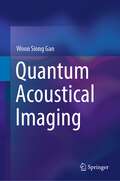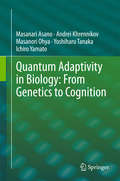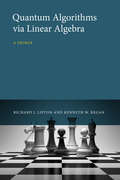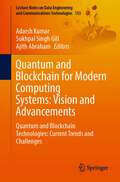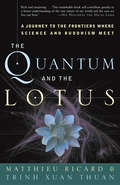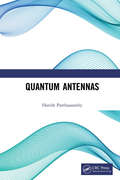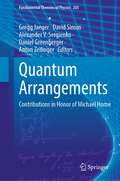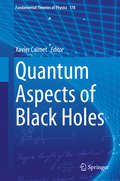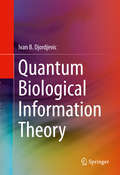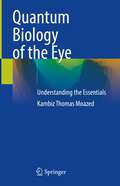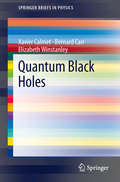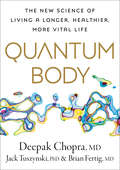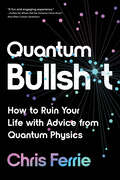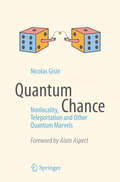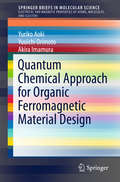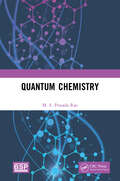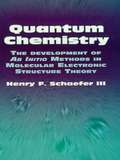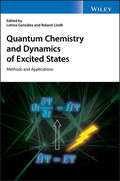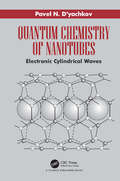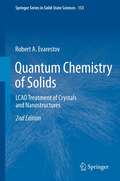- Table View
- List View
Quantum Acoustical Imaging
by Woon Siong GanThis book highlights the theories and applications of quantum acoustical imaging which can be considered as a part of quantum technology. It starts with the theories and background principles of this new field in depth.The examples of some present forms of available acoustical imaging which can be considered as quantum acoustical imaging are given such as ultrasonics in the terahertz range with the use of optical transducers for producing terahertz ultrasound and the theory of sound amplification by stimulated emission of radiation (SASER) and principles based on terahertz ultrasound. The SASER transducer is described, followed by the applications of SASER.Other examples of quantum acoustical imaging are the atomic force acoustic microscope (AFAM) and the ultrasonic force microscope. The author’s personal inventions of quantum acoustical imaging are a system based on phonons entanglement based on the quantum property of phonons entanglement and the quantum ultrasound diffraction tomography system.The advantage of quantum acoustical imaging is the defeat of the classical Rayleigh image resolution limit. An unique feature of this book is that it has gone in depth into the quantum theories of acoustical imaging such as phonons entanglement,,superposition principle and the application of transport theory.Quantum microphones and quantum transducers are also introduced with a final chapter on quantum image processing.
Quantum Adaptivity in Biology: From Genetics to Cognition
by Masanari Asano Andrei Khrennikov Masanori Ohya Yoshiharu Tanaka Ichiro YamatoThis book examines information processing performed by bio-systems at all scales: from genomes, cells and proteins to cognitive and even social systems. It introduces a theoretical/conceptual principle based on quantum information and non-Kolmogorov probability theory to explain information processing phenomena in biology as a whole. The book begins with an introduction followed by two chapters devoted to fundamentals, one covering classical and quantum probability, which also contains a brief introduction to quantum formalism, and another on an information approach to molecular biology, genetics and epigenetics. It then goes on to examine adaptive dynamics, including applications to biology, and non-Kolmogorov probability theory. Next, the book discusses the possibility to apply the quantum formalism to model biological evolution, especially at the cellular level: genetic and epigenetic evolutions. It also presents a model of the epigenetic cellular evolution based on the mathematical formalism of open quantum systems. The last two chapters of the book explore foundational problems of quantum mechanics and demonstrate the power of usage of positive operator valued measures (POVMs) in biological science. This book will appeal to a diverse group of readers including experts in biology, cognitive science, decision making, sociology, psychology, and physics; mathematicians working on problems of quantum probability and information and researchers in quantum foundations.
Quantum Algorithms via Linear Algebra: A Primer
by Richard J. Lipton Kenneth W. ReganQuantum computing explained in terms of elementary linear algebra, emphasizing computation and algorithms and requiring no background in physics.This introduction to quantum algorithms is concise but comprehensive, covering many key algorithms. It is mathematically rigorous but requires minimal background and assumes no knowledge of quantum theory or quantum mechanics. The book explains quantum computation in terms of elementary linear algebra; it assumes the reader will have some familiarity with vectors, matrices, and their basic properties, but offers a review of all the relevant material from linear algebra. By emphasizing computation and algorithms rather than physics, this primer makes quantum algorithms accessible to students and researchers in computer science without the complications of quantum mechanical notation, physical concepts, and philosophical issues.After explaining the development of quantum operations and computations based on linear algebra, the book presents the major quantum algorithms, from seminal algorithms by Deutsch, Jozsa, and Simon through Shor's and Grover's algorithms to recent quantum walks. It covers quantum gates, computational complexity, and some graph theory. Mathematical proofs are generally short and straightforward; quantum circuits and gates are used to illuminate linear algebra; and the discussion of complexity is anchored in computational problems rather than machine models. Quantum Algorithms via Linear Algebra is suitable for classroom use or as a reference for computer scientists and mathematicians.
Quantum and Blockchain for Modern Computing Systems: Quantum and Blockchain Technologies: Current Trends and Challenges (Lecture Notes on Data Engineering and Communications Technologies #133)
by Adarsh Kumar Sukhpal Singh Gill Ajith AbrahamThis book states that blockchain technology provides a secure distributed, peer-to-peer, and decentralized network with advanced cryptography primitives and protocols. The important question that arises in the quantum computing world is to test the existing blockchain networks against quantum attacks and design quantum computing enabled secure blockchain solutions. This book encourages professionals from different fields to provide blockchain and quantum technology-integrated solutions that incorporate low-cost, effective QoS, fast, secure, and futuristic demands. This book has surveyed and proposed approaches that improve quantum computing and cryptography protocols. Quantum computing and quantum science are not just helpful in software but the hardware world as well. To design networks with quantum science, quantum-enabled devices like quantum memories and quantum repeaters can be useful to demonstrate for organizations. For example, designing a single quantum repeater for long-distance quantum communication is useful in reducing the network cost, and ensuring better security levels. This book has introduced the quantum computing and blockchain technology aspects, their integration approaches and future directions.
The Quantum and the Lotus: A Journey to the Frontiers Where Science and Buddhism Meet
by Matthieu Ricard Trinh Xuan ThuanMatthieu Ricard trained as a molecular biologist, working in the lab of a Nobel prize—winning scientist, but when he read some Buddhist philosophy, he became drawn to Buddhism. Eventually he left his life in science to study with Tibetan teachers, and he is now a Buddhist monk and translator for the Dalai Lama, living in the Shechen monastery near Kathmandu in Nepal. Trinh Thuan was born into a Buddhist family in Vietnam but became intrigued by the explosion of discoveries in astronomy during the 1960s. He made his way to the prestigious California Institute of Technology to study with some of the biggest names in the field and is now an acclaimed astrophysicist and specialist on how the galaxies formed. When Matthieu Ricard and Trinh Thuan met at an academic conference in the summer of 1997, they began discussing the many remarkable connections between the teachings of Buddhism and the findings of recent science. That conversation grew into an astonishing correspondence exploring a series of fascinating questions. Did the universe have a beginning? Or is our universe one in a series of infinite universes with no end and no beginning? Is the concept of a beginning of time fundamentally flawed? Might our perception of time in fact be an illusion, a phenomenon created in our brains that has no ultimate reality? Is the stunning fine-tuning of the universe, which has produced just the right conditions for life to evolve, a sign that a “principle of creation” is at work in our world? If such a principle of creation undergirds the workings of the universe, what does that tell us about whether or not there is a divine Creator? How does the radical interpretation of reality offered by quantum physics conform to and yet differ from the Buddhist conception of reality? What is consciousness and how did it evolve? Can consciousness exist apart from a brain generating it? The stimulating journey of discovery the authors traveled in their discussions is re-created beautifully inThe Quantum and the Lotus, written in the style of a lively dialogue between friends. Both the fundamental teachings of Buddhism and the discoveries of contemporary science are introduced with great clarity, and the reader will be profoundly impressed by the many correspondences between the two streams of thought and revelation. Through the course of their dialogue, the authors reach a remarkable meeting of minds, ultimately offering a vital new understanding of the many ways in which science and Buddhism confirm and complement each other and of the ways in which, as Matthieu Ricard writes, “knowledge of our spirits and knowledge of the world are mutually enlightening and empowering. ” From the Hardcover edition.
Quantum Antennas
by Harish ParthasarathyThis book is about several questions regarding how to describe the quantization of the current density in an antenna and about the nature of the quantum electromagnetic field produced by such a quantum current density. The second quantized current density can be built out of the Dirac field of electrons and positrons while the free electromagnetic or photon field is built out of solutions to the wave equation with coefficients being operators, namely the creation and annihilation operators of the photons. Note: T&F does not sell or distribute the Hardback in India, Pakistan, Nepal, Bhutan, Bangladesh and Sri Lanka.
Quantum Arrangements: Contributions in Honor of Michael Horne (Fundamental Theories of Physics #203)
by Gregg Jaeger David Simon Alexander V. Sergienko Daniel Greenberger Anton ZeilingerThis book presents a collection of novel contributions and reviews by renowned researchers in the foundations of quantum physics, quantum optics, and neutron physics. It is published in honor of Michael Horne, whose exceptionally clear and groundbreaking work in the foundations of quantum mechanics and interferometry, both of photons and of neutrons, has provided penetrating insight into the implications of modern physics for our understanding of the physical world. He is perhaps best known for the Clauser-Horne-Shimony-Holt (CHSH) inequality. This collection includes an oral history of Michael Horne's contributions to the foundations of physics and his connections to other eminent figures in the history of the subject, among them Clifford Shull and Abner Shimony.
Quantum Aspects of Black Holes
by Xavier CalmetBeginning with an overview of the theory of black holes by the editor, this book presents a collection of ten chapters by leading physicists dealing with the variety of quantum mechanical and quantum gravitational effects pertinent to black holes. The contributions address topics such as Hawking radiation, the thermodynamics of black holes, the information paradox and firewalls, Monsters, primordial black holes, self-gravitating Bose-Einstein condensates, the formation of small black holes in high energetic collisions of particles, minimal length effects in black holes and small black holes at the Large Hadron Collider. Viewed as a whole the collection provides stimulating reading for researchers and graduate students seeking a summary of the quantum features of black holes.
Quantum Aspects of Black Holes (Fundamental Theories of Physics #178)
by Xavier CalmetBeginning with an overview of the theory of black holes by the editor, this book presents a collection of ten chapters by leading physicists dealing with the variety of quantum mechanical and quantum gravitational effects pertinent to black holes. The contributions address topics such as Hawking radiation, the thermodynamics of black holes, the information paradox and firewalls, Monsters, primordial black holes, self-gravitating Bose-Einstein condensates, the formation of small black holes in high energetic collisions of particles, minimal length effects in black holes and small black holes at the Large Hadron Collider. Viewed as a whole the collection provides stimulating reading for researchers and graduate students seeking a summary of the quantum features of black holes.
Quantum Atom Optics: Theory and Applications to Quantum Technology
by Tim Byrnes Ebubechukwu O. Ilo-OkekeThe rapid development of quantum technologies has driven a revolution in related research areas such as quantum computation and communication, and quantum materials. The first prototypes of functional quantum devices are beginning to appear, frequently created using ensembles of atoms, which allow the observation of sensitive, quantum effects, and have important applications in quantum simulation and matter wave interferometry. This modern text offers a self-contained introduction to the fundamentals of quantum atom optics and atomic many-body matter wave systems. Assuming a familiarity with undergraduate quantum mechanics, this book will be accessible for graduate students and early career researchers moving into this important new field. A detailed description of the underlying theory of quantum atom optics is given, before development of the key, quantum, technological applications, such as atom interferometry, quantum simulation, quantum metrology, and quantum computing.
Quantum Biological Information Theory
by Ivan B. DjordjevicThis book is a self-contained, tutorial-based introduction to quantum information theory and quantum biology. It serves as a single-source reference to the topic for researchers in bioengineering, communications engineering, electrical engineering, applied mathematics, biology, computer science, and physics. The book provides all the essential principles of the quantum biological information theory required to describe the quantum information transfer from DNA to proteins, the sources of genetic noise and genetic errors as well as their effects. Integrates quantum information and quantum biology concepts; Assumes only knowledge of basic concepts of vector algebra at undergraduate level; Provides a thorough introduction to basic concepts of quantum information processing, quantum information theory, and quantum biology; Includes in-depth discussion of the quantum biological channel modelling, quantum biological channel capacity calculation, quantum models of aging, quantum models of evolution, quantum models on tumor and cancer development, quantum modeling of bird navigation compass, quantum aspects of photosynthesis, quantum biological error correction.
Quantum Biology of the Eye: Understanding the Essentials
by Kambiz Thomas MoazedAs we enter the quantum era, new research on applying the rules of quantum physics to biology, which was previously considered impossible, has revolutionized our understanding and our concept of molecular and atomic particles behavior and their interactions. This book is the first comprehensive review of the quantum biology of the visual system. Chapters discuss the relevance of quantum physics to the biological systems, especially in the visual system. The main purpose of this book is to simplify quantum biology concepts relevant to physiology of human eye and to help the reader understand the essentials of this new emerging, complex and anti-intuitive field of science. It offers a contemporary view of the emerging interplay between the biochemistry, physiology, molecular biology, and molecular and atomic particle quantum characteristics such as vibration, spin etc.Quantum Biology of the Eye is an essential resource for Ophthalmologists, physicians, residents, fellows, all fields of visual science and medical students in ophthalmology, and other converging fields of science such as visual optics biochemists, psychology etc.
Quantum Black Holes
by Xavier Calmet Bernard Carr Elizabeth WinstanleyWritten by foremost experts, this short book gives a clear description of the physics of quantum black holes. The reader will learn about quantum black holes in four and higher dimensions, primordial black holes, the production of black holes in high energy particle collisions, Hawking radiation, black holes in models of low scale quantum gravity and quantum gravitational aspects of black holes.
Quantum Body: The New Science of Living a Longer, Healthier, More Vital Life
by Deepak Chopra Jack Tuszynsk Brian FertigJoining forces with two leading scientists, New York Times bestselling author Deepak Chopra offers a quantum leap for improving our physical and mental health. In an unprecedented collaboration between three of today&’s most powerful minds, Deepak Chopra, M.D., teams up with physicist Jack Tuszynski, Ph.D., and endocrinologist Brian Fertig, M.D., to bring readers a visionary work that delves into the innovative world of quantum science and shows how unlocking its secrets can revolutionize how we live and age—and, ultimately, how we can eradicate disease. The key is the quantum body. Unlike our physical body, which is subject to aging, injury, and decay, the quantum body exists on a sub-atomic level and is the infinite, invisible source of everyday reality that affects your thoughts, feelings, sensations, and biological responses. Without your quantum body, there is no physical body. And this lack of awareness of the most crucial part of ourselves negatively impacts our lives every day. Through a powerful combination of prescriptive exercises and innovative research into the quantum world, the authors unveil seven breakthroughs that will revolutionize the future of everyone&’s well-being. Central to this revolution is a groundbreaking understanding of metabolism—the way our cells process energy—that promises to challenge our understanding of modern medicine as we know it.Though all too familiar in the physical world, Alzheimer&’s, type 2 diabetes, cancer, and heart disease do not exist at the fundamental level of quantum reality. By harnessing the power of the quantum body, we can significantly improve our physical and mental well-being, including supporting healthy cell, tissue, and organ function, boosting immunity, promoting mental resilience, and expanding our understanding of what it means to live a happy and purposeful life.In this groundbreaking book, Chopra, Tuszynski, and Fertig show you the way by unveiling the &“real&” reality of your body and mind as never before and providing a vision for a tomorrow that is already here.
Quantum Bullsh*t: How to Ruin Your Life with Advice from Quantum Physics
by Chris FerrieScience is so f*cking rad. We don't deserve it.What actually is quantum physics? If you can answer that questions without bullsh*tting the person standing next to you in the bookstore, you can stop reading right now. But although most of us don't actually understand quantum physics, we know that it's mystical and awesome, and if we understood it we'd probably be rich and beautiful and happy, right? After all, there are plenty of people out there trying to sell you quantum crystals to align your quantum energy with your quantum destiny. Can they all be wrong?Spoiler: yes. Yes, they can. There is no such thing as quantum crystals. Sorry!Luckily, as pseudo-science takes over the internet and it's getting harder and harder to separate alternative facts from real science, Chris Ferrie (an actual quantum physicist!) is here to explain quantum physics in a way that makes sense, so you can see the hucksters and bullsh*tters coming from a mile away—and school them in what quantum entanglement actually is (it has nothing to do with your romantic life). If you f*cking love science and want to be slightly less dumb than you were when you woke up this morning, Quantum Bullsh*t is the truly out-of-this-world book for you.
Quantum Chance
by Nicolas GisinQuantum physics, which offers an explanation of the world on the smallest scale, has fundamental implications that pose a serious challenge to ordinary logic. Particularly counterintuitive is the notion of entanglement, which has been explored for the past 30 years and posits an ubiquitous randomness capable of manifesting itself simultaneously in more than one place. This amazing 'non-locality' is more than just an abstract curiosity or paradox: it has entirely down-to-earth applications in cryptography, serving for example to protect financial information; it also has enabled the demonstration of 'quantum teleportation', whose infinite possibilities even science-fiction writers can scarcely imagine. This delightful and concise exposition does not avoid the deep logical difficulties of quantum physics, but gives the reader the insights needed to appreciate them. From 'Bell's Theorem' to experiments in quantum entanglement, the reader will gain a solid understanding of one of the most fascinating areas of contemporary physics.
Quantum Chance: Nonlocality, Teleportation and Other Quantum Marvels
by Nicolas GisinQuantum physics, which offers an explanation of the world on the smallest scale, has fundamental implications that pose a serious challenge to ordinary logic. Particularly counterintuitive is the notion of entanglement, which has been explored for the past 30 years and posits an ubiquitous randomness capable of manifesting itself simultaneously in more than one place.This amazing 'non-locality' is more than just an abstract curiosity or paradox: it has entirely down-to-earth applications in cryptography, serving for example to protect financial information; it also has enabled the demonstration of 'quantum teleportation', whose infinite possibilities even science-fiction writers can scarcely imagine.This delightful and concise exposition does not avoid the deep logical difficulties of quantum physics, but gives the reader the insights needed to appreciate them. From 'Bell's Theorem' to experiments in quantum entanglement, the reader will gain a solid understanding of one of the most fascinating areas of contemporary physics.
Quantum Chemical Approach for Organic Ferromagnetic Material Design
by Yuriko Aoki Yuuichi Orimoto Akira ImamuraThis brief provides an overview of theoretical research in organic ferromagnetic material design using quantum chemical approaches based on molecular orbital theory from primary H#65533;ckel to ab initio levels of theory. Most of the content describes the authors' approach to identify simple and efficient guidelines for magnetic design, which have not been described in other books. Individual chapters cover quantum chemistry methods that may be used to find hydrocarbon systems with degenerate non-bonding molecular orbitals that interact with each other, to identify high-spin-preferred systems using an analytical index that allows for simple design of high-spin systems as well as to analyze the effect of high-spin stability through orbital interactions. The extension of these methods to large systems is discussed. This book is a valuable resource for students and researchers who are interested in quantum chemistry related to magnetic property.
Quantum Chemistry
by M. S. RaoQuantum Chemistry provides a coherent and structured approach in introducing the concept of 'quantum' to the students of quantum mechanics. An attempt is made to bring out the subtleties of quantum mechanics, hidden in its abstract laws and equations, applicable to the atomic domain by showing its relevance to the observable macroscopic world as well. The book will help students dispel the stigma associated with quantum mechanics. The emphasis on conceptual approach provides a platform to stand on, and a stimulus to pursue higher quantum mechanics—the doorway to the all-pervasive quantum world. Print edition not for sale in South Asia (India, Sri Lanka, Nepal, Bangladesh, Pakistan or Bhutan).
Quantum Chemistry: The Development of Ab Initio Methods in Molecular Electronic Structure Theory
by Henry F. Schaefer IIIThis guide is guaranteed to prove of keen interest to the broad spectrum of experimental chemists who use electronic structure theory to assist in the interpretation of their laboratory findings. A list of 150 landmark papers in ab initio molecular electronic structure methods, it features the first page of each paper (which usually encompasses the abstract and introduction). Its primary focus is methodology, rather than the examination of particular chemical problems, and the selected papers either present new and important methods or illustrate the effectiveness of existing methods in predicting a variety of chemical phenomena.
Quantum Chemistry and Dynamics of Excited States: Methods and Applications
by Leticia GonzálezAn introduction to the rapidly evolving methodology of electronic excited states For academic researchers, postdocs, graduate and undergraduate students, Quantum Chemistry and Dynamics of Excited States: Methods and Applications reports the most updated and accurate theoretical techniques to treat electronic excited states. From methods to deal with stationary calculations through time-dependent simulations of molecular systems, this book serves as a guide for beginners in the field and knowledge seekers alike. Taking into account the most recent theory developments and representative applications, it also covers the often-overlooked gap between theoretical and computational chemistry. An excellent reference for both researchers and students, Excited States provides essential knowledge on quantum chemistry, an in-depth overview of the latest developments, and theoretical techniques around the properties and nonadiabatic dynamics of chemical systems. Readers will learn: ● Essential theoretical techniques to describe the properties and dynamics of chemical systems ● Electronic Structure methods for stationary calculations ● Methods for electronic excited states from both a quantum chemical and time-dependent point of view ● A breakdown of the most recent developments in the past 30 years For those searching for a better understanding of excited states as they relate to chemistry, biochemistry, industrial chemistry, and beyond, Quantum Chemistry and Dynamics of Excited States provides a solid education in the necessary foundations and important theories of excited states in photochemistry and ultrafast phenomena.
Quantum Chemistry of Nanotubes: Electronic Cylindrical Waves
by Pavel N. D'yachkovThis book gives a detailed and up-to-date overview of the linearized augmented cylindrical wave (LACW) technique for nanotubes and nanowires. The author presents the mathematical foundations together with numerous applications. Method for calculating the electronic structure of point impurities, which is based on a combination of the LACW and Green’s functions techniques, is presented. The book clearly demonstrates how the relativistic effects can be incorporated into LACW approach and how the spin-orbit coupling effects change the tubules band structure. Extensive illustrations of application to the inorganic nanotubes and nanowires make the book essential reading in this field above all.
Quantum Chemistry of Solids
by Robert A. EvarestovQuantum Chemistry of Solids delivers a comprehensive account of the main features and possibilities of LCAO methods for the first principles calculations of electronic structure of periodic systems. The first part describes the basic theory underlying the LCAO methods applied to periodic systems and the use of Hartree-Fock(HF), Density Function theory(DFT) and hybrid Hamiltonians. The translation and site symmetry consideration is included to establish connection between k-space solid -state physics and real-space quantum chemistry. The inclusion of electron correlation effects for periodic systems is considered on the basis of localized crystalline orbitals. The possibilities of LCAO methods for chemical bonding analysis in periodic systems are discussed. The second part deals with the applications of LCAO methods for calculations of bulk crystal properties, including magnetic ordering and crystal structure optimization. In the second edition two new chapters are added in the application part II of the book. Chapter 12 deals with the recent LCAO calculations and illustrates the efficiency of the scalar-relativistic LCAO method for solids, containing heavy atoms. Chapter 13 deals with the symmetry properties and the recent applications of LCAO method to inorganic nanotubes. New material is added to chapter 9 devoted to LCAO calculations of perfect-crystal properties. The possibilities of LCAO method for calculation of the high-frequency dielectric constants of crystals and the description of phase transitions in solids are discussed. The efficiency of LCAO method in the quantum-mechanics-molecular dynamics approach to the interpretation of x-ray absorption and EXAFS spectra is illustrated. A new section is devoted to recent LCAO calculations of electronic, vibrational and magnetic properties of tungstates MeWO4 (Me: Fe,Co,Ni,Cu,Zn,Cd).
Quantum Chemistry Simulation of Biological Molecules
by Eudenilson L. Albuquerque Umberto L. Fulco Ewerton W. Caetano Valder N. FreireNano-biotechnology crosses the boundaries between physics, biochemistry and bioengineering, and has profound implications for the biomedical engineering industry. This book describes the quantum chemical simulation of a wide variety of molecular systems, with detailed analysis of their quantum chemical properties, individual molecular configurations, and cutting-edge biomedical applications. Topics covered include the basic properties of quantum chemistry and its conceptual foundations, the nanoelectronics and thermodynamics of DNA, the optoelectronic properties of the five DNA/RNA nucleobase anhydrous crystals, and key examples of molecular diode prototypes. A wide range of important applications are described, including protein binding of drugs such as cholesterol-lowering, anti-Parkinson and anti-migraine drugs, and recent developments in cancer biology are also discussed. This modern and comprehensive text is essential reading for graduate students and researchers in multidisciplinary areas of biological physics, chemical physics, chemical engineering, biochemistry and bioengineering.
Quantum Chromodynamics
by B. L. Ioffe V. S. Fadin L. N. LipatovAimed at graduate students and researchers in theoretical physics, this book presents the modern theory of strong interaction: quantum chromodynamics (QCD). The book exposes various perturbative and nonperturbative approaches to the theory, including chiral effective theory, the problems of anomalies, vacuum tunnel transitions, and the problem of divergence of the perturbative series. The QCD sum rules approach is exposed in detail. A great variety of hadronic properties (masses of mesons and baryons, magnetic moments, form factors, quark distributions in hadrons, etc. ) have been found using this method. The evolution of hadronic structure functions is presented in detail, together with polarization phenomena. The problem of jets in QCD is treated through theoretical description and experimental observation. The connection with Regge theory is emphasized. The book covers many aspects of theory which are not discussed in other books, such as CET, QCD sum rules, and BFKL.
